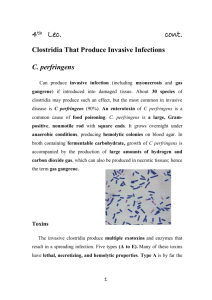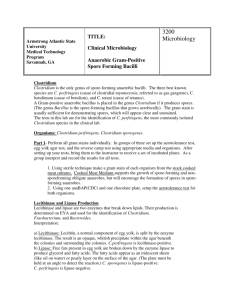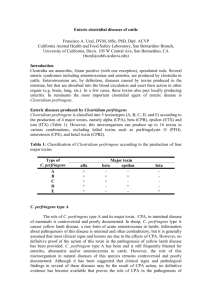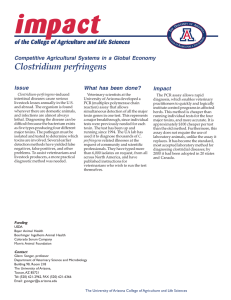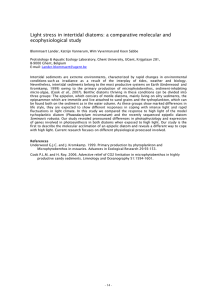Clostridium perfringens Indicator to Detect Intertidal Disposal at
advertisement
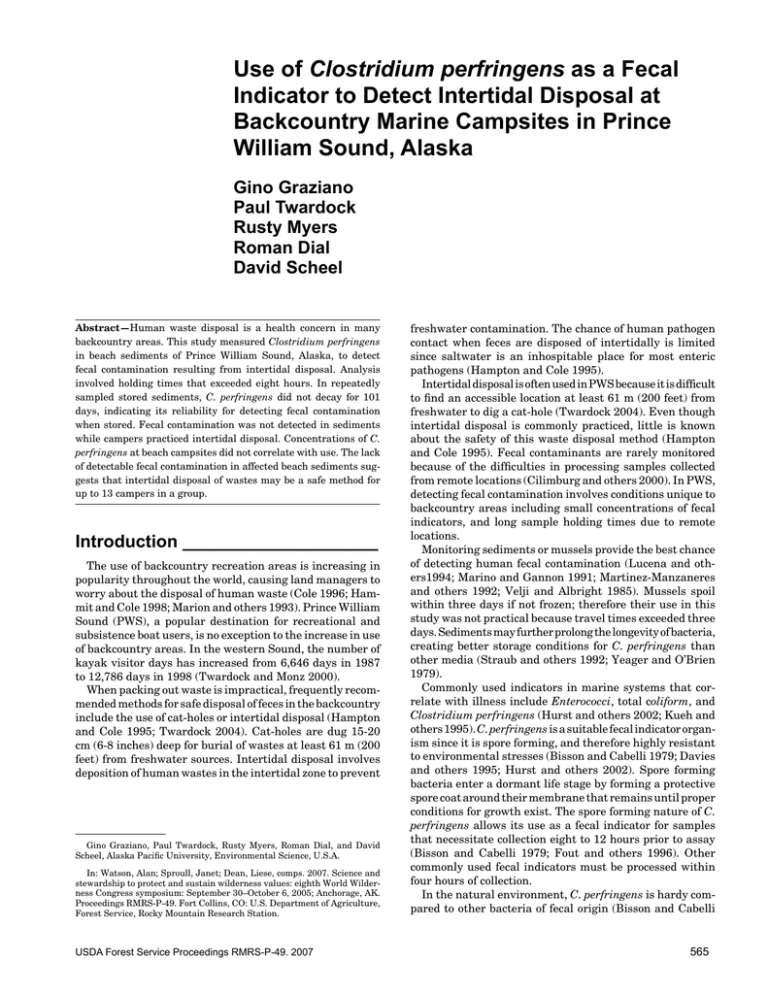
Use of Clostridium perfringens as a Fecal Indicator to Detect Intertidal Disposal at Backcountry Marine Campsites in Prince William Sound, Alaska Gino Graziano Paul Twardock Rusty Myers Roman Dial David Scheel Abstract—Human waste disposal is a health concern in many backcountry areas. This study measured Clostridium perfringens in beach sediments of Prince William Sound, Alaska, to detect fecal contamination resulting from intertidal disposal. Analysis involved holding times that exceeded eight hours. In repeatedly sampled stored sediments, C. perfringens did not decay for 101 days, indicating its reliability for detecting fecal contamination when stored. Fecal contamination was not detected in sediments while campers practiced intertidal disposal. Concentrations of C. perfringens at beach campsites did not correlate with use. The lack of detectable fecal contamination in affected beach sediments suggests that intertidal disposal of wastes may be a safe method for up to 13 campers in a group. Introduction_____________________ The use of backcountry recreation areas is increasing in popularity throughout the world, causing land managers to worry about the disposal of human waste (Cole 1996; Hammit and Cole 1998; Marion and others 1993). Prince William Sound (PWS), a popular destination for recreational and subsistence boat users, is no exception to the increase in use of backcountry areas. In the western Sound, the number of kayak visitor days has increased from 6,646 days in 1987 to 12,786 days in 1998 (Twardock and Monz 2000). When packing out waste is impractical, frequently recommended methods for safe disposal of feces in the backcountry include the use of cat-holes or intertidal disposal (Hampton and Cole 1995; Twardock 2004). Cat-holes are dug 15-20 cm (6-8 inches) deep for burial of wastes at least 61 m (200 feet) from freshwater sources. Intertidal disposal involves deposition of human wastes in the intertidal zone to prevent Gino Graziano, Paul Twardock, Rusty Myers, Roman Dial, and David Scheel, Alaska Pacific University, Environmental Science, U.S.A. In: Watson, Alan; Sproull, Janet; Dean, Liese, comps. 2007. Science and stewardship to protect and sustain wilderness values: eighth World Wilderness Congress symposium: September 30–October 6, 2005; Anchorage, AK. Proceedings RMRS-P-49. Fort Collins, CO: U.S. Department of Agriculture, Forest Service, Rocky Mountain Research Station. USDA Forest Service Proceedings RMRS-P-49. 2007 freshwater contamination. The chance of human pathogen contact when feces are disposed of intertidally is limited since saltwater is an inhospitable place for most enteric pathogens (Hampton and Cole 1995). Intertidal disposal is often used in PWS because it is difficult to find an accessible location at least 61 m (200 feet) from freshwater to dig a cat-hole (Twardock 2004). Even though intertidal disposal is commonly practiced, little is known about the safety of this waste disposal method (Hampton and Cole 1995). Fecal contaminants are rarely monitored because of the difficulties in processing samples collected from remote locations (Cilimburg and others 2000). In PWS, detecting fecal contamination involves conditions unique to backcountry areas including small concentrations of fecal indicators, and long sample holding times due to remote locations. Monitoring sediments or mussels provide the best chance of detecting human fecal contamination (Lucena and others1994; Marino and Gannon 1991; Martinez-Manzaneres and others 1992; Velji and Albright 1985). Mussels spoil within three days if not frozen; therefore their use in this study was not practical because travel times exceeded three days. Sediments may further prolong the longevity of bacteria, creating better storage conditions for C. perfringens than other media (Straub and others 1992; Yeager and O’Brien 1979). Commonly used indicators in marine systems that correlate with illness include Enterococci, total coliform, and Clostridium perfringens (Hurst and others 2002; Kueh and others 1995). C. perfringens is a suitable fecal indicator organism since it is spore forming, and therefore highly resistant to environmental stresses (Bisson and Cabelli 1979; Davies and others 1995; Hurst and others 2002). Spore forming bacteria enter a dormant life stage by forming a protective spore coat around their membrane that remains until proper conditions for growth exist. The spore forming nature of C. perfringens allows its use as a fecal indicator for samples that necessitate collection eight to 12 hours prior to assay (Bisson and Cabelli 1979; Fout and others 1996). Other commonly used fecal indicators must be processed within four hours of collection. In the natural environment, C. perfringens is hardy compared to other bacteria of fecal origin (Bisson and Cabelli 565 Graziano, Twardock, Myers, Dial, and Scheel 1979; Davies and others 1995; Fout and others 1996). In one study C. perfringens did not show significant decay with or without predation for up to 85 days while other fecal indicators decayed to 10 percent of their original population (Davies and others 1995). C. perfringens persistence may lend to reliable colony counts after long storage times en-route from remote locations. C. perfringens sensitivity and persistence leads to the possibility of measuring past pollution events that are not related to the current concentration of disease causing microorganisms (Bisson and Cabelli 1979; Fout and others 1996; Hurst and others 2002). In PWS, the sensitivity of C. perfringens for measuring use is optimal since human influence on pollutant levels is likely minimal in comparison to natural mammalian inputs. The feces of most mammals are composed of similar microorganisms including C. perfringens. Fecal contaminants from wildlife have made attempts to correlate human use with fecal contamination difficult (Flack and others 1988; Gary and Adams 1985; Silsbee and Larson 1982; Stuart and others 1976). To correlate recreational and other human use with C. perfringens concentrations the condition of the camp area can be measured using a Campsite Inventory and Monitoring Program protocol adapted to PWS by the National Outdoors Leadership School (Kehoe 2002). This monitoring protocol was used in the Sound by researchers to classify 100 beach campsites with a discrete condition class score using observed signs of human impact (table 1) (Monz 1998). Campsites monitored in PWS tended towards moderate to high impact (Monz 1998). The correlation between fecal contaminants with the condition class score described above has not been studied. Since C. perfringens detects present as well as past pollution events it provides the greatest likelihood of detecting enteric bacteria accumulation affected by intertidal disposal. This study investigates the following hypotheses regarding the use of C. pefringens in beach sediments as a fecal indicator organism and medium appropriate for use when sample holding times exceed 12 hours. Use of Clostridium perfringens as a Fecal Indicator to Detect Intertidal Disposal . . . • Repeated subsamples of stored sediments should not differ significantly in concentration from the initial sample. • Sequential samples of sediments taken before, during, and after camper use will detect accumulation of C. perfringens resulting from intertidal disposal. • Camp condition class scores will have a positive correlation with fecal contaminants if intertidal disposal results in accumulation of C. perfringens in sediments. • Heavily used areas (Blackstone Bay) will have elevated C. perfringens concentrations compared to low traffic areas (Icy Bay) if intertidal disposal is a significant influence. Methods________________________ Study Area The study focused on the western Prince William Sound (PWS) area from Whittier to Seward. Twardock and Monz (2000) found that the total kayak visitor days spent in PWS was greatest for areas closest to Whittier. Icy Bay (low use), Blackstone Bay (high use), and the area in-between the bays (intermediate use) were included for comparisons (fig. 1). These areas are within the Nellie Juan Wilderness Study Area containing over half of the shoreline in PWS. Icy Bay is managed as a wilderness area allowing no permanent land modifications. Blackstone Bay is managed under a backcountry prescription plan, which allows for site improvements to accommodate heavier use. The additional areas studied included two beaches in Resurrection Bay and two beaches on the outer coast area from PWS to Resurrection Bay (fig. 1). Resurrection Bay area beaches experience relatively high use, and some beach camps not included in this study have existing pit toilets. The outer coast between Whittier and Seward is a remote area on the Gulf of Alaska with minimal use and ample tidal action. Table 1–Measures used to determine condition class score of a camp. 566 Measure Condition class Score 0-5 (0 is no impact 5 is heavy impact) Vegetation cover inside 1-6 (1 = 0-5%, 2= 6-25%, 3=26-50%, 4=51-75%, 5=76-95%, 6=96-100%) Vegetation cover outside 1-6 (1 = 0-5%, 2= 6-25%, 3=26-50%, 4=51-75%, 5=76-95%, 6=96-100%) Mineral soil exposure 1-6 (1 = 0-5%, 2= 6-25%, 3=26-50%, 4=51-75%, 5=76-95%, 6=96-100%) Tree damage None-slight, moderate, severe Root exposure None-slight, moderate, severe # of tree stumps Count # of trails leaving site Count # of fire sites Count Litter and trash observations None, some, much Observable human waste Yes or no USDA Forest Service Proceedings RMRS-P-49. 2007 Use of Clostridium perfringens as a Fecal Indicator to Detect Intertidal Disposal . . . Graziano, Twardock, Myers, Dial, and Scheel Figure 1—Backcountry beach campsites visited in western Prince William Sound and Resurrection Bay, Alaska. Experimental Design Correlation of Storage Time With C. perfringens Concentration. To test the effect of storage time on C. perfringens concentration, experimentally contaminated sediments at serial treatments were stored and assayed. A composite of sediments collected from several PWS beaches were thoroughly mixed in a bucket, and subdivided into beakers. Sediments were submerged in artificial seawater (Instant Ocean®) with a salinity of approximately 33 0/00. The sediment seawater mixtures were autoclaved in a 9.5 L pressure cooker for 25 minutes at 1.25 to 1.50 kg cm-2. After sterilization, the excess water was drained. Raw wastewater sewage, obtained from the John M. Asplund Anchorage Water and Wastewater Utility, was added to sterilized sediments in the following amounts per 100 gr sediment: 20 mL, 10 mL, 2 mL, and 1 mL. Treated sediments were stored in sterilized (20 percent bleach) 0.5 L amber Nalgene® bottles. Subsampling and assay were performed within four hours of the raw sewage treatment according to standard procedures, additional assays were performed regularly (Fout and others 1996). The treated samples were stored in a soft-shelled ice chest with ice packs added daily for the first 23 days. After storage for 23 days samples were kept in a refrigerator at 2 to 3 °C (36 to 37 °F) for the duration of the 101 and one-day experiment. This temperature regime USDA Forest Service Proceedings RMRS-P-49. 2007 mimics what samples collected from remote sites and stored for later processing might experience. Correlation of Camper Use With C. perfringens Concentration. Sampling was undertaken from 5/11-27/2004 with an Alaska Pacific University Expedition Sea Kayaking course consisting of 13 people. Students were informed of the acceptable disposal methods, and upon arrival at a beach the lead instructor and I indicated to the group a good spot to intertidally dispose of waste. I sampled sediments from the indicated location. When camping, an initial sediment sample was collected upon arrival, a second sample was taken at night once the campers had retired, and a third sample was taken in the early morning before campers awoke. Correlation of Area Accessibility and Camp Condition With C. perfringens Concentration. Sampling was completed by kayak and charter boat from 7/11-23/2004. An area predicted to have low impact (Icy Bay) was compared to an area predicted to have high impact (Blackstone Bay), and to an area geographically between them that should experience intermediate impact (fig. 1). The level of impact at beach campsites was quantified with a condition class rating derived from the Campsite Inventory and Monitoring Program protocol (table 1) (Kehoe 2002). The condition class was used to compare beaches of high and low impact independently of their location in PWS. 567 Graziano, Twardock, Myers, Dial, and Scheel Use of Clostridium perfringens as a Fecal Indicator to Detect Intertidal Disposal . . . Sediment Collection and Field Handling Collected sediments were taken from the water-shore interface with a flame-sterilized trowel. Sediment samples were taken from the top 4 cm (2 inches) of beach substrate to fill a pre-washed (20 percent bleach) 0.5 L sample container (amber Nalgene® bottle, Snap-n-Seal® plastic freezer zip bags). While in the field, sediment samples were stored in a cool place such as the shade or the hull of a kayak. Upon arrival in Anchorage, sediment samples were stored in a refrigerator (2 to 3 ºC) until processed for incubation of C. perfringens. Sample Preparation and Lab Assays The medium for C. perfringens incubation (mCP) was prepared according to published methods (Bisson and Cabelli 1979; Fout and others 1996). Prior to subsampling, sediments were thoroughly mixed by shaking ten times in a circular motion. Subsamples were aseptically removed and suspended in water using a ratio of 10 gr sediment to 90 mL de-ionized (DI) water. Once sediment was suspended in water the solution was vigorously shaken 100 times to dislodge bacteria from sediment. After shaking, the sediment water mixture was allowed to settle for 10 minutes. Then aliquots of supernatant were removed and vacuumed through membrane filters with 0.45 µm pore size (Metricel). Membranes containing filtrate were placed on mCP agar plates and incubated at 44.5 °C (112 °F) for 24 hours in an anaerobic chamber with an anaerobic atmosphere generator (Anaerocult). After incubation, the straw yellow bacteria colonies that turned pink to magenta after exposure to NH4OH fumes were considered acid phosphatase positive which indicates the presence of C. perfringens (Bisson and Cabelli 1979; Fout and others 1996). Condition Class Condition class at each sampled camp was determined from several observational measures of tent sites (table 1) (Kehoe 2002). Condition was assigned a discrete score from zero (no impact) to five (heavy impact). When multiple tent sites were present at a single beach, the mean impact was used to describe the condition of the camp. Method Detection Limit (MDL) The MDL determines what concentrations of C. perfringens were statistically greater than zero with 99 percent confidence (three standard deviations). The MDL was calculated according to the Code of Federal Regulations (Hach 2003). Raw wastewater sewage was added to sterilized sediments at a concentration of 1.0, 2.0, 10.0, and 20.0 mL sewage 100 gr-1 sediment. The MDL was calculated as the product of the standard deviation for the mean colony forming units of the replicates taken from the contaminated sediment and the upper critical student’s t value for the number of replicates (table 2). The dilution used to determine the MDL was the least concentrated dilution that exhibited a mean concentration higher than the calculated MDL. When values are below the MDL the variance in these sample means is too large to determine group differences or correlations with a variable such as time (Helsel 2005). When concentrations were below the MDL for more than 60 percent of the samples, I censored the data as values below (0) or above the MDL (1), and used appropriate non-parametric test statistics (Helsel 2005; Helsel and Hirsch 1991). Statistical Analysis Analysis of the effect of storage time on C. perfringens concentration was completed using a bivariate correlation. Pearson’s R was used when values were consistently above the MDL. Kendall’s tau non-parametric test statistic was used when the data were grouped as detectable or not detectable because more than 60 percent of the concentrations were below the MDL (Helsel 2005; Helsel and Hirsch 1991). For the analysis of beach sediments at remote sites during use and the comparison of beach sediments by areas and condition class, differences between sample groups and detection of C. perfringens were analyzed using a chi-square analysis. Since more than 60 percent of the concentrations were below the MDL, the values are labeled as detectable and non-detectable (Helsel 2005; Helsel and Hirsch 1991). The frequency of detectable samples at each time, condition and area are compared with Cramer’s V non-parametric test statistic. Results_________________________ Method Detection Limit (MDL) This study’s MDL for the membrane filtration method for C. perfringens was calculated from the product of the student’s t and the standard deviation of 8 replicates from a 2.0 mL sewage 100 gr-1 sediment dilution (table 2). The product of the standard deviation and the student’s t for the replicates results in a detection limit for C. perfringens of 9 cfu gr-1 of sediment. Table 2—Method detection limit (MDL) calculation for each dilution measured. Sample dilution Replicates 1 mL sewage/100 gr. sediment 2 mL sewage/100 gr. sediment 10 mL sewage/100 gr. sediment 20 mL sewage/100 gr. sediment 568 9 7 8 7 Upper critical Student T 2.896 2.998 2.896 2.998 Mean C. perfringens cfu gram-1 9 12 39 59 Standard deviation 7 3 4 5 Method detection limit 20 9 12 15 USDA Forest Service Proceedings RMRS-P-49. 2007 Use of Clostridium perfringens as a Fecal Indicator to Detect Intertidal Disposal . . . Discussion______________________ Correlation of Storage Time With C. perfringens Concentration When sediment samples experimentally contaminated with wastewater sewage were stored, C. perfringens concentrations were not correlated with time for the 1 mL and 20 mL treatments (fig. 2, 1 mL treatment all days not detectable, fig. 3, 20 mL treatment Pearson’s R = -0.294, N = 17, p = 0.252). The correlation between time and the concentrations measured for the 2 mL and 10 mL treatments was significant (fig. 2, 2 mL treatment Kendall’s tau R = -0.485, N = 17, p = 0.021, fig. 3, 10 mL treatment Pearson’s R = -0.638, N = 17, p = 0.006). Correlation of Camper Use With C. perfringens Concentration When campers practiced intertidal disposal there was no statistical differences in the C. perfringens detection rates among sediment sample times (Cramer’s V = 0.218, N = 24, p = 0.565). The two samples that detected C. perfringens were an initial sample and a morning sample from different beaches (table 3). This study was unable to detect C. perfringens during use of intertidal disposal. Correlation of Area and Condition Class With C. perfringens Concentration The mean condition class scores indicated higher impact in Blackstone Bay (mean = 4, SD = 1.12) than Icy Bay (mean = 0.8, SD = 1.19 Post hoc p = 0.001, SE = 0.755). Despite the higher impact seen in Blackstone Bay beaches, no difference existed between the detection rate of C. perfringens at these beaches compared to the beaches in Icy bay and other areas (table 3, Cramer’s V = 0.333, N = 21 beaches, p = 0.311). Analysis of the difference in the detection rate between beaches with a condition class score that indicated low impact (0-1), middle impact (2-3) and high impact (4-5) showed no statistically significant differences between these groups (table 3, Cramer’s V = 0.365, N = 21 beaches, p = 0.247). Table 3—Detection of C. perfringens in samples during camper use, and for beaches in area and condition class score categories. During camper use Initia Night Morning Area Comparison Icy Bay Blackstone Bay Other areas Condition Class Low (score 0-1) Middle (score 2-3) High (score 4-5) % detected Cramer’s V 8.3 0.218 12.5 0.0 12.5 14.3 0.333 28.6 0.0 14.3 14.3 0.365 28.6 20.0 0.0 USDA Forest Service Proceedings RMRS-P-49. 2007 Graziano, Twardock, Myers, Dial, and Scheel N P 24 8l 8 8 21 7 7 7 21 7 5 9 0.565 0.311 0.247 Previous researchers examined the decay of bacteria in sediments over time in semi-natural states, while this study examined the persistence of C. perfringens in stored sediment samples to assess the impact of intertidal disposal. Clostridium perfringens can be used as a reliable fecal indicator when stored for prolonged periods to detect pollution above the Method Detection Limit (MDL). The time stored did not effect detection of pollution in sediment samples, although a negative correlation between time and concentration is suggested (figs. 2 and 3). Results indicate that stored C. perfringens remains viable with little growth or decay for up to 101 days, which is supported by C. perfringens’ viability in natural environments (Davies and others1995). The use of C. pefringens to detect fecal pollution was not affected by storage in this study despite a statistically significant decrease in the concentration of two wastewater sewage treated sediments (figs. 2 and 3). C. perfringens is an anaerobe and would be in the dormant spore form while present in aerobic marine sediments (Davies and others 1995). When stored, spores likely remained dormant since conditions were not anaerobic. While in the spore form, C. perfringens remains viable for an undetermined time whereas other fecal indicator bacteria decay under similar conditions (Davies and others 1995; LaLiberte and Grimes 1982; Pommepuy and others 1992). Population decay in most fecal indicators is significantly affected by protozoa predation (Davies and others 1995; LaLiberte and Grimes 1982; Marino and Gannon 1991). Predation on C. perfringens was not considered in this study since the presence of protozoa has been shown to have little to no effect on the concentration of viable C. perfringens spores (Davies and others 1995). Given the biological nature of spore forming anaerobes, it is expected that predation during storage would have no significant effect on C. perfringens concentration. A statistically significant negative correlation with time was noticed in the study when two stored sediment samples had higher concentrations of C. perfringens occurring in the first 21 days (figs. 2 and 3). While the vast majority of C. perfringens are in the spore form and do not decay, the remaining vegetative cells show total decay when in marine sediments for 30 or more days (Davies and others 1995). This may explain the significant loss of C. perfringens in the 2 and 10 mL wastewater sewage treatments. The remaining stored sediments showed statistically insignificant negative relationships. This is likely because these samples were regularly below the detection limit, or had a higher overall concentration of C. perfringens resulting in a less significant proportion of the population in the vegetative form. Despite the suggested negative correlation between concentration and storage time, C. perfringens did not decay to the extent that pollution or a lack of pollution could not be determined. While campers practicing intertidal disposal were present on a beach, accumulation of C. perfringens in beach sediments was not detected between sequential samples (table 3). The difficulty in detecting intertidal disposal with bacteria was likely due to the small and short-term effects the practice has on local bacterial concentrations. Intertidal disposal of fecal matter results in dilution of contaminants to low 569 Graziano, Twardock, Myers, Dial, and Scheel Use of Clostridium perfringens as a Fecal Indicator to Detect Intertidal Disposal . . . Figure 2—Effect of storage time on the detection of C. perfringens. A value of zero represents concentrations below the MDL while a value of one represents detectable concentrations of C. perfringens. The error bars represent the 95 percent confidence interval of the means. Figure 3—The effect of storage time on the concentration of C. perfringens for the 10 mL sewage 100gr-1 sediment (O) and 20 mL sewage 100 gr-1 sediment (∆) treatments. 570 USDA Forest Service Proceedings RMRS-P-49. 2007 Use of Clostridium perfringens as a Fecal Indicator to Detect Intertidal Disposal . . . concentrations (Hampton and Cole 1995). Depending on site conditions, minute amounts of C. perfringens are likely to settle in the sediment near the disposal site. The sequential samples taken while campers practiced intertidal disposal were below the detection limit for 92 percent of the samples (table 3). These results support the assumption that intertidal disposal does not significantly affect the C. perfringens population. In beach sediments collected at campsites in Prince William Sound, 86 percent of the samples had C. perfringens concentrations below the MDL indicating minimal human fecal contamination (table 3). Three PWS sites exhibited values 5 to 15 times greater than the detection limit indicating human or animal contamination (table 3). Low concentrations of fecal bacteria would be expected in PWS because of its size, pristine nature, constant tidal flushing, and low exposure to human wastes. The low concentration of C. perfringens seen in PWS beach sediments indicates little chance of exposure to pathogens through contact with intertidal waters. The absence of detectable human contamination in the sediments does not guarantee that intertidal disposal is a safe process. If waste is disposed in the intertidal zone, bacteria are present in the area for a short period before dispersal. Given the low concentration of C. perfringens in beach sediments, if contaminants are present in the water there is a small potential for human pathogen contact. Disposal sites should be located far enough away from camps in areas of significant tidal flushing to ensure proper dilution and minimize transport of waste to the camping beach. Fecal indicator concentrations did not differ by distance from the nearest access point, Whittier, to the areas studied in PWS (table 3). Measured impact at the beaches also did not correlate with C. perfringens concentrations (table 3). Differences between areas and beaches of various condition class scores are difficult to detect statistically in studies because the impact of human inputs on the bacterial population is minimal (Flack and others 1988; Gary and Adams 1985; Silsbee and Larson 1982). I found human use of the sampled beaches did not significantly affect the C. perfringens population. Despite lack of a significant correlation between C. perfringens and camp conditions, a slight trend of lower C. perfringens concentrations at areas showing higher human impacts existed (table 3). Icy Bay, the area farthest from Whittier and consequently less impacted, had two beaches with C. perfringens concentrations that were 4 to 16 times the MDL. The only other sample with a similar concentration was in the intermediate use area (table 3). The same trend in detection rates holds for comparison between condition class groups of low, medium and high impact. The low impact group showed the most detection (two detects) followed by the middle impact group (one detect), and the high impact group with no detectable C. perfringens concentrations (table 3). This suggests that humans may possibly decrease the C. perfringens concentrations at beaches that are heavily impacted. If increasing human impact is keeping C. perfringens concentrations down, it is possible that the primary source of C. perfringens at PWS beaches is from wild mammals. A similar study compared a watershed closed to recreational use with a watershed used for recreation, and found that human USDA Forest Service Proceedings RMRS-P-49. 2007 Graziano, Twardock, Myers, Dial, and Scheel impact lowered bacteria concentrations due to decreased animal inputs (Stuart and others 1976). At the use levels studied, intertidal disposal of human waste does not result in accumulation of C. perfringens in beach sediments. If future studies concern the effect of intertidal disposal on bacterial concentrations while campers use a beach, then increased replication and impact is necessary. Sampling the beaches before, during and after use for two to three days would provide a picture of the normal variability as well as the duration and extent of impacts to bacteria concentrations at campsites that are used for extended periods. Increasing the number of campers and monitoring the amount of fecal input would provide information regarding the input necessary to detect contamination. Further study of the correlation between condition class and C. perfringens concentration would benefit from sampling beaches with values above and below the MDL at multiple times during the season. Early, middle and late season trips to measure the condition class of camps, as well as C. perfringens concentrations in sediments will provide data regarding the progression of impact and bacterial concentrations. Sampling these same camps annually would further corroborate any relationship between camp condition and C. perfringens. Campers sometimes practice intertidal disposal in the Sound as an alternative to disposing of feces in the uplands (Twardock 2004). In the Sound, when the uplands are accessible, it is difficult to find places that are sufficiently distant from freshwater sources to dispose of feces (Twardock 2004). These freshwater sources are ephemeral, and waste deposited on a dry surface may later become inundated by freshwater. Since pathogen populations can persist for up to 200 days in the soil, upland disposal could expose campers to pathogens the following season (Hurst and others 2002; Yeager and O’Brien 1979). Campers practicing intertidal disposal in this study did not affect the C. perfringens sediment concentrations. This study suggests that recreational use of PWS does not significantly affect the population of C. perfringens, and may be driving wild animals away resulting in a reduction of bacterial inputs at campsites with increased human impact. These data suggest that when practiced properly intertidal disposal does not increase the chance of exposure to fecal contaminants, and may be the best method for waste removal when it is not possible to pack out wastes or use the uplands properly. References______________________ Bisson, J. W.; Cabelli, V. J. 1979. Membrane filter enumeration method for Clostridium perfringens. Applied and Environmental Microbiology. 37(1): 55–66. Cilimburg, Amy; Monz, C.; Kehoe, S. 2000. Wildland recreation and human waste: a review of problems, practices, and concerns. Environmental Management. 25(6): 587–598. Cole, D. N. 1996. Wilderness recreation in the United States: trends in use, users, and impacts. International Journal of Wilderness. 2(3): 14–18. Davies, C. M.; Long, J. A. H.; Donald, M.; Ashbolt, N. J. 1995. Survival of fecal microorganisms in marine and freshwater sediments. Applied and Environmental Microbiology. 61(5): 1888–1896. Flack, J. E.; Medine, A. J.; Hansen-Bristow, K. J. 1988. Stream water quality in a mountain recreation area. Mountain Research and Development. 8(1): 11–22. 571 Graziano, Twardock, Myers, Dial, and Scheel Fout, F. Shay; Schaefer, F. W.; Messer, J. W.; Dahling, D. R.; Stetler, R. E. 1996. Membrane filtration method for C. perfringens. In: ICR Microbial Laboratory Manual. Washington, DC: United States Environmental Protection Agency Office of Research and Development: XI-1–XI-15. Gary, H. L.; Adams, J. C. 1985. Indicator bacteria in water and stream sediments near the snowy range in southern Wyoming. Journal of Water, Air and Soil pollution. 25: 133–144. Hach 2003. Hach water analysis handbook. 4th Edition Revision 2. Hach Chemical Company, PO Box 300, Loveland, Colorado 80537. Hammit, W. E.; Cole, D. N. 1998. Wildland recreation: ecology and management. 2nd edition. New York: John Wiley. 361 p. Hampton, Bruce; Cole, D. 1995. Soft paths. The National Outdoor Leadership School. Mechanicsburg, PA: Stackpole Books. 240 p. Helsel, D. R. 2005. Nondetects and data analysis: statistics for censored environmental data. Statistics in practice. New York: Wiley-Interscience. 268 p. Helsel, D. R.; Hirsch, R. M. 1991. Statistical methods in water resources. In: U.S. Geological Survey. Techniques of waterresources investigations. Book 4, Chapters A3, 12 and 13. U.S. Department of the Interior, U.S. Geological Survey. [Online]. Available: http://water.usgs.gov/pubs/twri/twri4a3/html/pdf_new. html. [July 23, 2006]. Hurst, C. J.; Crawford, R. L.; Knudsen, G. R.; McInerney, M. J.; Stetzenbach, L. D., eds. 2002. Manual of environmental microbiology. 2nd Edition. Washington, DC: American Society of Microbiology Press. 666 p. Kehoe, Sharon. 2002. Campsite inventory and monitoring program for Prince William Sound, Alaska, a procedural manual. Lander, WY: National Outdoor Leadership School. 26 p. Kueh, C. S. W.; Tam, T. Y.; Lee, T.; Wong, S. L.; Lloyd, O. L.; Yu, I. T. S.; Wong, T. W.; Tam, J. S.; Bassett, D. C. J. 1995. Epidemiological study of swimming associated illnesses relating to bathing beach water quality. Water Science and Technology. 31: 1–4. LaLiberte, P.; Grimes, D. J. 1982. Survival of Escerichia coli in lake bottom sediment. Applied and Envionmental Microbiology. 43: 623–628. Lucena, F.; Lasobras, J.; McIntosh, D.; Forcadell, M.; Jofre, J. 1994. Effect of distance from the polluting focus on relative concentrations of Bacteriodes fragilis phages and coliphages in mussels. Applied and Environmental Microbiology. 60(7): 2272–2277. Marion, J. L.; Roggenbuck, J. W.; Manning, R. E. 1993. Problems and practices in backcountry recreation management: a survey of National Park Service managers. Natural Resources Report NPS/NRVT/NPR.93/12. Denver, CO: U.S. Department of Interior. National Park Service, Natural Resources Publication Office. 65 p. 572 Use of Clostridium perfringens as a Fecal Indicator to Detect Intertidal Disposal . . . Marino, R. P.; Gannon, J. J. 1991. Survival of fecal coliforms and fecal streptococci in storm drain sediment. Water Research. 25(9): 1089–1098. Martinez-Manzaneres, E.; Morinigo, M. A.; Castro, D.; Balebona, M. C.; Sanchez, J. M.; Borrego, J. J. 1992. Influence of the fecal pollution of marine sediments on the microbial content of shellfish. Marine Pollution Bulletin. 24(7): 342–349. Monz, Christopher A. 1998. Monitoring recreation resource impacts in two coastal areas of western North America: an initial assessment. In: Watson, Alan E; Aplet, Greg H.; Hendee, John C., comps. Personal, Societal and Ecological Values of Wilderness: Sixth World Wilderness Congress Proceedings on research, management, and allocation. Vol. 1. Proc. RMRS-P-4. Ogden, UT: U.S. Department of Agriculture, Forest Service, Rocky Mountain Research Station: 117–122. Pommepuy. M.; Guillaud, J. F.; Dupray, E.; Derrien, A.; Le Guyader, F.; Cormier, M. 1992. Enteric bacterial survival factors. Water Science Technology. 12: 93–103. Silsbee, D. G.; Larson, G. L. 1982. Bacterial water quality: springs and streams in the Great Smoky Mountains National Park. Environmental Management. 6(4): 353–359. Straub, T. M.; Pepper, I. L.; Gerba, C. P. 1992. Persistence of viruses in desert soils amended with anaerobically digested sewage sludge. Applied and Environmental Microbiology. 58(2): 636–641. Stuart, S. A.; McFeters, G. A.; Schillinger, J. E.; Stuart, D. G. 1976. Aquatic indicator bacteria in the high alpine zone. Applied and Environmental Microbiology. 31(2): 163–167. Twardock, Paul. 2004. Kayaking & camping in Prince William Sound. Valdez, AK: Prince William Sound Books. 214 p. Twardock, Paul; Monz, C. 2000. Recreational kayak visitor use, distribution, and financial value of beaches in western Prince William Sound, Alaska, between 1987 and 1998. In: Cole, David N.; McCool, Stephen F.; Borrie, William T.; O’Loughlin, Jennifer, comps. 2000. Wilderness science in a time of change conference—Volume 4: Wilderness visitors, experiences, and visitor management; 1999 May 23–27; Missoula, MT. Proceedings RMRS-P-15-VOL-4. Ogden, UT: U.S. Department of Agriculture, Forest Service, Rocky Mountain Research Station:175–180. [Online]. Available: http://www.fs.fed.us/rm/pubs/rmrs_p015_4/ rmrs_p015_4_175_180.pdf. [July 23, 2006]. Velji, M. I.; Albright, L. J. 1985. Microscopic enumeration of attached marine bacteria of seawater, marine sediment, fecal matter, and kelp blade samples following pyrophosphate and ultrasound treatments. Canadian Journal of Microbiology. 32: 121–126. Yeager, J. G.; O’Brien, R. T. 1979. Enterovirus inactivation in soil. Applied and Environmental Microbiology. 38: 694–701. USDA Forest Service Proceedings RMRS-P-49. 2007

